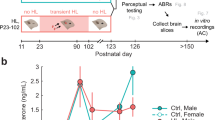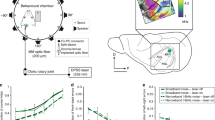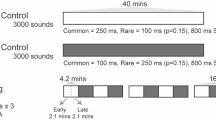Abstract
During early brain development and through 'adult' experience-dependent plasticity, neural circuits are shaped to represent the external world with high fidelity. When raised in a quiet environment, the rat primary auditory cortex (A1) has a well-defined 'critical period', lasting several days, for its representation of sound frequency. The addition of environmental noise extends the critical period duration as a variable function of noise level. It remains unclear whether critical period closure should be regarded as a unified, externally gated event that applies for all of A1 or if it is controlled by progressive, local, activity-driven changes in this cortical area. We found that rearing rats in the presence of a spectrally limited noise band resulted in the closure of the critical period for A1 sectors representing the noise-free spectral bands, whereas the critical period appeared to remain open in noise-exposed sectors, where the cortex was still functionally and physically immature.
This is a preview of subscription content, access via your institution
Access options
Subscribe to this journal
Receive 12 print issues and online access
$209.00 per year
only $17.42 per issue
Buy this article
- Purchase on Springer Link
- Instant access to full article PDF
Prices may be subject to local taxes which are calculated during checkout






Similar content being viewed by others
References
Kilgard, M.P. et al. Sensory input directs spatial and temporal plasticity in primary auditory cortex. J. Neurophysiol. 86, 326–338 (2001).
Goodman, J.C. & Nusbaum, H.C. The Development of Speech Perception: The Transition from Speech Sounds to Spoken Words (MIT Press, Cambridge, Massachusetts, 1994).
Moore, D.R., Hutchings, M.E. & Meyer, S.E. Binaural masking level differences in children with a history of otitis media. Audiology 30, 91–101 (1991).
Rice, F.L. & Van der Loos, H. Development of the barrels and barrel field in the somatosensory cortex of the mouse. J. Comp. Neurol. 171, 545–560 (1977).
Schlaggar, B.L. & O'Leary, D.D. Patterning of the barrel field in somatosensory cortex with implications for the specification of neocortical areas. Perspect. Dev. Neurobiol. 1, 81–91 (1993).
de Villers-Sidani, E., Chang, E.F., Bao, S. & Merzenich, M.M. Critical period window for spectral tuning defined in the primary auditory cortex (A1) in the rat. J. Neurosci. 27, 180–189 (2007).
Fagiolini, M., Pizzorusso, T., Berardi, N., Domenici, L. & Maffei, L. Functional postnatal development of the rat primary visual cortex and the role of visual experience: dark rearing and monocular deprivation. Vision Res. 34, 709–720 (1994).
Berardi, N., Pizzorusso, T. & Maffei, L. Critical periods during sensory development. Curr. Opin. Neurobiol. 10, 138–145 (2000).
Berardi, N., Pizzorusso, T., Ratto, G.M. & Maffei, L. Molecular basis of plasticity in the visual cortex. Trends Neurosci. 26, 369–378 (2003).
Stern, E.A., Maravall, M. & Svoboda, K. Rapid development and plasticity of layer 2/3 maps in rat barrel cortex in vivo. Neuron 31, 305–315 (2001).
Crair, M.C., Gillespie, D.C. & Stryker, M.P. The role of visual experience in the development of columns in cat visual cortex. Science 279, 566–570 (1998).
Chang, E.F. & Merzenich, M.M. Environmental noise retards auditory cortical development. Science 300, 498–502 (2003).
Zhang, L.I., Bao, S. & Merzenich, M.M. Disruption of primary auditory cortex by synchronous auditory inputs during a critical period. Proc. Natl. Acad. Sci. USA 99, 2309–2314 (2002).
Pearson, H.E., Berman, N. & Murphy, E.H. Stroboscopic rearing reduces direction selectivity in rabbit visual cortex. Brain Res. 227, 127–131 (1981).
Hensch, T.K. Critical period plasticity in local cortical circuits. Nat. Rev. Neurosci. 6, 877–888 (2005).
Zheng, W. & Knudsen, E.I. Functional selection of adaptive auditory space map by GABAA-mediated inhibition. Science 284, 962–965 (1999).
Chang, E.F., Bao, S., Imaizumi, K., Schreiner, C.E. & Merzenich, M.M. Development of spectral and temporal response selectivity in the auditory cortex. Proc. Natl. Acad. Sci. USA 102, 16460–16465 (2005).
Gordon, J.A. & Stryker, M.P. Experience-dependent plasticity of binocular responses in the primary visual cortex of the mouse. J. Neurosci. 16, 3274–3286 (1996).
Eggermont, J.J. Correlated neural activity as the driving force for functional changes in auditory cortex. Hear. Res. 229, 69–80 (2007).
Zhang, L.I. & Poo, M.M. Electrical activity and development of neural circuits. Nat. Neurosci. 4 Suppl, 1207–1214 (2001).
Xu, H., Kotak, V.C. & Sanes, D.H. Conductive hearing loss disrupts synaptic and spike adaptation in developing auditory cortex. J. Neurosci. 27, 9417–9426 (2007).
Pallas, S.L. Intrinsic and extrinsic factors that shape neocortical specification. Trends Neurosci. 24, 417–423 (2001).
de Venecia, R.K. & McMullen, N.T. Single thalamocortical axons diverge to multiple patches in neonatal auditory cortex. Brain Res. Dev. Brain Res. 81, 135–142 (1994).
Feldman, D.E., Nicoll, R.A., Malenka, R.C. & Isaac, J.T. Long-term depression at thalamocortical synapses in developing rat somatosensory cortex. Neuron 21, 347–357 (1998).
Alonso, J.M. & Swadlow, H.A. Thalamocortical specificity and the synthesis of sensory cortical receptive fields. J. Neurophysiol. 94, 26–32 (2005).
Daw, M.I., Ashby, M.C. & Isaac, J.T. Coordinated developmental recruitment of latent fast spiking interneurons in layer IV barrel cortex. Nat. Neurosci. 10, 453–461 (2007).
Gao, W.J. & Pallas, S.L. Cross-modal reorganization of horizontal connectivity in auditory cortex without altering thalamocortical projections. J. Neurosci. 19, 7940–7950 (1999).
McGee, A.W., Yang, Y., Fischer, Q.S., Daw, N.W. & Strittmatter, S.M. Experience-driven plasticity of visual cortex limited by myelin and Nogo receptor. Science 309, 2222–2226 (2005).
del Rio, J.A., de Lecea, L., Ferrer, I. & Soriano, E. The development of parvalbumin-immunoreactivity in the neocortex of the mouse. Brain Res. Dev. Brain Res. 81, 247–259 (1994).
Gao, W.J., Wormington, A.B., Newman, D.E. & Pallas, S.L. Development of inhibitory circuitry in visual and auditory cortex of postnatal ferrets: immunocytochemical localization of calbindin- and parvalbumin-containing neurons. J. Comp. Neurol. 422, 140–157 (2000).
Hendrickson, A.E., Van Brederode, J.F., Mulligan, K.A. & Celio, M.R. Development of the calcium-binding protein parvalbumin and calbindin in monkey striate cortex. J. Comp. Neurol. 307, 626–646 (1991).
Beierlein, M., Gibson, J.R. & Connors, B.W. A network of electrically coupled interneurons drives synchronized inhibition in neocortex. Nat. Neurosci. 3, 904–910 (2000).
Bi, G. & Poo, M. Synaptic modification by correlated activity: Hebb's postulate revisited. Annu. Rev. Neurosci. 24, 139–166 (2001).
Marco, P., Sola, R.G., Ramon y Cajal, S. & DeFelipe, J. Loss of inhibitory synapses on the soma and axon initial segment of pyramidal cells in human epileptic peritumoural neocortex: implications for epilepsy. Brain Res. Bull. 44, 47–66 (1997).
Somogyi, P., Tamas, G., Lujan, R. & Buhl, E.H. Salient features of synaptic organisation in the cerebral cortex. Brain Res. Brain Res. Rev. 26, 113–135 (1998).
Micheva, K.D. & Beaulieu, C. Neonatal sensory deprivation induces selective changes in the quantitative distribution of GABA-immunoreactive neurons in the rat barrel field cortex. J. Comp. Neurol. 361, 574–584 (1995).
Jiao, Y., Zhang, C., Yanagawa, Y. & Sun, Q.Q. Major effects of sensory experiences on the neocortical inhibitory circuits. J. Neurosci. 26, 8691–8701 (2006).
Daw, N.W., Fox, K., Sato, H. & Czepita, D. Critical period for monocular deprivation in the cat visual cortex. J. Neurophysiol. 67, 197–202 (1992).
Desai, N.S., Cudmore, R.H., Nelson, S.B. & Turrigiano, G.G. Critical periods for experience-dependent synaptic scaling in visual cortex. Nat. Neurosci. 5, 783–789 (2002).
Goel, A. & Lee, H.K. Persistence of experience-induced homeostatic synaptic plasticity through adulthood in superficial layers of mouse visual cortex. J. Neurosci. 27, 6692–6700 (2007).
Hooks, B.M. & Chen, C. Critical periods in the visual system: changing views for a model of experience-dependent plasticity. Neuron 56, 312–326 (2007).
Bartoletti, A., Medini, P., Berardi, N. & Maffei, L. Environmental enrichment prevents effects of dark-rearing in the rat visual cortex. Nat. Neurosci. 7, 215–216 (2004).
Cang, J. et al. Development of precise maps in visual cortex requires patterned spontaneous activity in the retina. Neuron 48, 797–809 (2005).
Bao, S., Chang, E.F., Davis, J.D., Gobeske, K.T. & Merzenich, M.M. Progressive degradation and subsequent refinement of acoustic representations in the adult auditory cortex. J. Neurosci. 23, 10765–10775 (2003).
Kilgard, M.P. & Merzenich, M.M. Distributed representation of spectral and temporal information in rat primary auditory cortex. Hear. Res. 134, 16–28 (1999).
Bao, S., Chang, E.F., Woods, J. & Merzenich, M.M. Temporal plasticity in the primary auditory cortex induced by operant perceptual learning. Nat. Neurosci. 7, 974–981 (2004).
Brosch, M. & Schreiner, C.E. Correlations between neural discharges are related to receptive field properties in cat primary auditory cortex. Eur. J. Neurosci. 11, 3517–3530 (1999).
Eggermont, J.J. Neural interaction in cat primary auditory cortex. Dependence on recording depth, electrode separation and age. J. Neurophysiol. 68, 1216–1228 (1992).
Acknowledgements
We would like to thank T. Babcock, J. Zhang for technical support and J. Li for comments on the manuscript. This research was supported by US National Institutes of Health Grants grant NS-10414 and PO2 NS34835-09, the Sandler Fund and the Fonds de Recherche en Santé du Québec.
Author information
Authors and Affiliations
Contributions
E.d.V.-S. contributed to the experimental design, electrophysiological data collection, analysis and writing of the manuscript. K.L.S., Y.-F.L. and R.C.S.L. performed the histological analysis and edited the text. M.M.M. participated in experimental design and writing.
Corresponding author
Supplementary information
Supplementary Text and Figures
Supplementary Figure 1 (PDF 531 kb)
Rights and permissions
About this article
Cite this article
de Villers-Sidani, E., Simpson, K., Lu, YF. et al. Manipulating critical period closure across different sectors of the primary auditory cortex. Nat Neurosci 11, 957–965 (2008). https://doi.org/10.1038/nn.2144
Received:
Accepted:
Published:
Issue Date:
DOI: https://doi.org/10.1038/nn.2144
This article is cited by
-
Psychosis spectrum illnesses as disorders of prefrontal critical period plasticity
Neuropsychopharmacology (2023)
-
Central auditory deficits associated with genetic forms of peripheral deafness
Human Genetics (2022)
-
Creative music therapy to promote brain structure, function, and neurobehavioral outcomes in preterm infants: a randomized controlled pilot trial protocol
Pilot and Feasibility Studies (2017)
-
Sound Interferes with the Early Tactile Manual Abilities of Preterm Infants
Scientific Reports (2016)
-
Differential maturation of vesicular glutamate and GABA transporter expression in the mouse auditory forebrain during the first weeks of hearing
Brain Structure and Function (2016)



